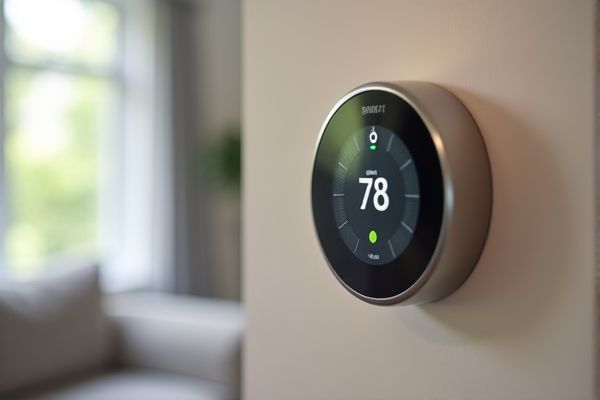
Smart thermostats offer precise temperature control, energy-saving features, and remote access via smartphone apps, unlike traditional thermostats that require manual adjustments and lack automation. Discover how upgrading to a smart thermostat can enhance your home's comfort and efficiency by reading the rest of this article.
Table of Comparison
| Feature | Smart Thermostat | Traditional Thermostat |
|---|---|---|
| Temperature Control | Remote control via app, adaptive learning | Manual adjustment on device |
| Energy Efficiency | Optimizes usage, reduces energy bills | Fixed schedules, less efficient |
| Integration | Works with smart home systems (Alexa, Google Home) | Standalone, no smart integration |
| Installation | Requires Wi-Fi, professional or DIY setup | Simple wiring, DIY-friendly |
| Cost | Higher upfront cost, long-term savings | Lower upfront cost, no long-term savings |
| User Interface | Touchscreen or app-based | Basic manual dials or buttons |
| Learning Capability | Adaptive learning based on habits | No learning capability |
Introduction to Thermostats: Smart vs Traditional
Smart thermostats feature advanced sensors, Wi-Fi connectivity, and programmable settings that optimize energy use and enhance user convenience. Traditional thermostats offer basic temperature control with manual adjustments and limited automation. The integration of smart technology in thermostats leads to improved energy efficiency and remote accessibility compared to conventional models.
How Smart Thermostats Work
Smart thermostats use Wi-Fi connectivity and advanced sensors to monitor and adjust home temperatures based on user preferences, occupancy, and weather forecasts. They analyze real-time data through algorithms and learning capabilities to optimize energy efficiency and maintain comfort without manual input. Unlike traditional thermostats, smart models provide remote control via smartphones and integrate with home automation systems for seamless temperature management.
Traditional Thermostat Functions
Traditional thermostats regulate temperature using basic mechanical or digital mechanisms, allowing you to set a fixed target temperature manually. These devices typically lack connectivity features, relying on user adjustments to maintain desired comfort levels throughout the day. Your energy consumption may be higher compared to smart thermostats due to limited automation and no adaptive learning capabilities.
Energy Efficiency Comparison
Smart thermostats optimize energy consumption by learning your schedule and adjusting temperatures automatically, resulting in significant energy savings compared to traditional thermostats that rely on manual settings. Studies show smart thermostats can reduce heating and cooling energy use by up to 20-30%, whereas traditional models maintain constant temperature settings regardless of occupancy. Your energy bills decrease as smart thermostats fine-tune climate control in real time, improving efficiency and reducing waste.
Installation Process and Compatibility
Smart thermostats offer straightforward installation processes compatible with most HVAC systems, typically requiring a Wi-Fi connection and a smartphone app for setup. Traditional thermostats usually have simpler wiring but lack flexibility or remote control features, making them compatible primarily with standard heating and cooling units. Choosing a smart thermostat can enhance Your system's efficiency while ensuring smooth integration with modern home automation setups.
Cost Analysis: Upfront and Long-Term Savings
Smart thermostats typically have a higher upfront cost, ranging from $100 to $250, compared to traditional thermostats that average between $20 and $50. Despite the initial investment, smart thermostats can lead to long-term savings by optimizing energy usage, potentially reducing heating and cooling bills by 10-15%. Your energy efficiency improves through features like programmable schedules and remote control, resulting in substantial cost savings over time.
Remote Access and Control Features
Smart thermostats offer remote access and control through smartphone apps, allowing users to adjust temperature settings from anywhere with an internet connection. Traditional thermostats generally lack this capability, requiring manual adjustments directly on the device. The ability to program schedules and receive real-time energy usage reports remotely enhances convenience and energy efficiency with smart thermostats, features absent in traditional models.
Integration with Smart Home Systems
Smart thermostats offer seamless integration with various smart home systems such as Alexa, Google Home, and Apple HomeKit, enabling voice control and automation routines. Traditional thermostats lack connectivity features, requiring manual adjustments and standalone operation without remote access. Integration capabilities of smart thermostats enhance energy efficiency by allowing scheduling, geofencing, and real-time monitoring through mobile apps.
Maintenance and Reliability
Smart thermostats feature advanced diagnostics and remote monitoring capabilities that reduce maintenance needs and quickly alert users to potential issues, enhancing overall reliability. Traditional thermostats often require manual inspection and calibration, which can lead to overlooked problems and inconsistent performance over time. The integration of AI and predictive analytics in smart thermostats ensures proactive maintenance, minimizing downtime and increasing system longevity.
Which Thermostat is Right for You?
Smart thermostats offer advanced features such as remote control, learning algorithms, and energy usage reports, making them ideal for tech-savvy users seeking energy efficiency and convenience. Traditional thermostats provide straightforward manual control and reliability, suitable for those who prefer simplicity and lower upfront costs. Choosing the right thermostat depends on your lifestyle, budget, and willingness to engage with smart home technology.
 homyna.com
homyna.com